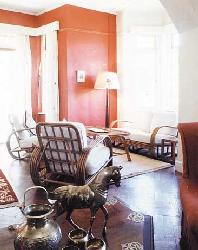 |
 15th March 1998 |
Front Page| |
Nayabedde tells a story of care"This bungalow is our home," the planter's wife said proudly. She was explaining to a visitor why the bungalow looked so cosy compared with the atmosphere of dust and despair of some plantation houses. "That's what makes the difference." The visitor is prepared for something special by the orderliness of the landscape revealed after the turn off from the Bandarawela to Poonagalla road. Where the road forks to the Nayabedde Estate, the scene becomes one of pastoral prettiness. Neat houses lodge in terraces on the hillside, paddy glistens in the valley and the tea bushes are bright with good care. The Nayabedde Estate includes St. Catherine's and rises to an elevation of 6,100 feet above sea level. At its apex, it joins two famous estates, Thomas Lipton's Dambatenne and Pitaratmalie, both previously reviewed in this column. There are views there of the whole southeast coast as well as of Badulla and the northeast range. However, Nayabedde itself is at the lower elevation of just over 4,000 feet, thereby qualifying its 1,000 acres of tea as High Grown. There is no drive sweeping up to the entrance of the Nayabedde bungalow, only steps up through the garden to a porch. And it is the garden that tells the story of the care lavished on this property. Who knows which planter's wife worked so hard to create a garden so lush and enchanting it resembles a tropical park? Instead of flowers regimented in borders, it sprawls with exotic plants, tiny tiered lawns, rambling paths and shaded arbours. A stream feeds a well kept pond, a huge boulder is crowned with concrete battlements as a child's castle, jacaranda trees shed their flowers like confetti. "It is a big privilege to experience this," says Ilwa Murray, wife of Ken Murray, the resident planter. "That's why we are so particular to look after it properly. The property is part of this country's inheritance which must be kept going." It is rare to find historical records on plantations; usually they have either disappeared or are lost in files at head office. At Nayabedde, the reports of Visiting Agents dating back to 1920 have been preserved. They show that the original bungalow was built in 1914 and that for 30 years, from 1919, the same planter, F .R. Francillon, lived there. He must be the one responsible for the original loveliness of Nayabedde, while his successors have worked hard to maintain its style. In 1925 the mud brick walls were replaced with stone in lime. Teak shingles, which have to be oiled every year, were added. Although white ants were reported in 1941 it was not until 45 years later, in 1986, that they were successfully exterminated, recalls Mrs. Murray. The Murrays try, with the addition of their own period furniture, to maintain the dignified image of the bungalow. Although the exterior of the rugged granite block walls have been painted white and the teak window frames are green, the interior retains its charm. The single red painted wall, framed by a white proscenium arch, is an acceptable contemporary touch.
A passageway perpendicular to the corridor passes a spare bedroom, the access to the servants' quarters at the rear of the bungalow, and leads to a door to the garden, as a side entrance. The dining room is here , a room distinguished not only by its period furniture but also by its leaded, diamond shape window panes set in teak frames. The bay of the window is edged with teak shelves which could also serve as window seats offering an attractive outdoor view. Such seats once graced the bay window of the planter's bedroom until someone misguidedly removed them. Exquisite roses, some as single stems others as co-ordinated displays, which complement the bungalow's decor, are from the collection of over 1,000 blooms grown by Mrs Murray herself. Her dedication to the bungalow and the family tradition of Ken Murray, a third generation planter, combine to maintain the splendour that is Nayabedde. It is an example to every planter and his wife of how the tea industry's bungalow heritage can be preserved. |
||
|
Front Page| News/Comment| Editorial/Opinion| Business| Sports | Mirror Magazine |
||
|
Please send your comments and suggestions on this web site to The Sunday Times or to Information Laboratories (Pvt.) Ltd. |
||


